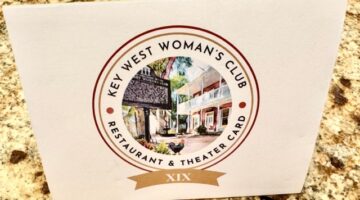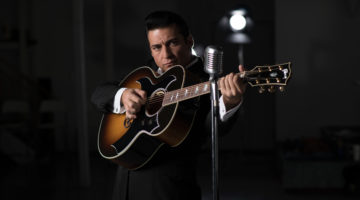PHOTO/
Crockett and Tubbs bring style to the Keys.
Looking Back on ‘Miami Vice’
KONK LIFE STAFF WRITER
“Miami Vice” first hit the small screen 30 years ago with a two-hour episode titled “Brother’s Keeper” on Sept. 16, 1984.
The show ran for five seasons and ultimately had a lasting impact on the life and culture of South Florida and the Keys, especially on how those places were viewed by the rest of the nation, indeed the world.
It is said that the 1980s began when Crockett and Tubbs cruised through a glittering Miami night in Crockett’s black Ferrari Daytona Spyder toward a showdown with a cocaine kingpin while Phil Collins’ “In The Air Tonight” simmered on the soundtrack.
“Vice” was created for NBC by Anthony Yerkovich and directed by Michael Mann, who launched his formidable Hollywood reputation through the series.
It starred Don Johnson as Florida kiddo “Sonny” Crockett and Philip Michael Thomas as Bronx boy Ricardo “Rico” Tubbs, two detectives who happened to find themselves working undercover for the Metro-Dade Police Department. The series ran on NBC from 1984 to 1989. The USA Network then began airing reruns annually and indeed broadcast an original, unaired episode in January 1990.
It was not the first TV show to pair a white cop with a black cop (that distinction goes to the 1965-1968 series “I Spy” featuring Robert Culp and Bill Cosby, but “Miami Vice” is considered the first program that truly revealed why color TV was invented.
The tag line to the show became “MTV Cops” due to its use of contemporary songs at least twice per episode, each of them memorable. Musicians whose music was used on the show ranged from Willie Nelson, Ted Nugent, Frank Zappa, Little Richard, James Brown and the Eagles, whose Glen Frey both wrote and sang the song “You Belong to the City” for the episode in which he played a leading part. Frey also wrote and performed the song “Smuggler’s Blues” for a second-series show in which he appeared as a shady pilot who flies Crockett and Tubbs to Columbia to they can arrange a drug buy. And singer Sheena Easton appeared in several episodes as Crockett’s wife.
By far the most significant cultural impact of “Miami Vice” was the role it played in culturally rejuvenating Miami Beach and the city of Miami itself. In the course of the production, the show’s production team actually restored several dilapidated buildings on South Beach. No other TV show could be credited with revitalizing a city to quite this degree.
The Keys’ connections to the show begin with the very first episode, in which Crockett warns Tubbs that his chained alligator named Elvis is freaked out because it once consumed a flight bag full of the drug LSD rom a lab in Key West. Subsequent episodes were rife with asides such as, “I know a terrific bar in the Keys…”
In 2005, Mann made a film version of “Miami Vice” updated to the 21st century. Starring Colin Farrell and Jamie Fox, several of its scenes were shot on Old State Road 4A in Upper Sugarloaf.
Another Keys connection occurred during the heyday of the series in the form of Danny Coll, who recently narrowly lost, for a second time, the race for Monroe County commissioner.
“Miami Vice” producers several times approached Coll to ask him if he’d ask customers at his exotic-car repair shop in Miami whether they’d be willing to lend an exotic car for use in an episode. Most said yes.
In addition to the cars in “Miami Vice,” there were the boats, for example Crockett’s Wellcraft Scarab 38-foot KV (whose manufacturer once produced a model with the same color scheme as in the series).
A typical fan from the very first episode, Key West resident Tim Gratz, recalls the race between Crockett, driving a Camaro, and Tubbs, with Crockett’s stolen Scarab, is roaring with it along the Intracoastal. Crockett finally recaptures his boat only by leaping onto it from a bridge over the Waterway at full speed. “Ah, ‘Miami Vice,’” exults Gratz, “who can forget such style?”
Don Johnson, 64, who was just 30 years old when the show premiered, set a new trend at the time with his pastel T-shirts and linen suits. He recently looked back on all of that with the Irish Independent newspaper — the Irish have always adored him — about how he has put it all behind him now. Readily admitting that he lived a life of unbridled hedonism, bingeing on booze, cocaine and beautiful women, there came a point when he was sitting on the porch of his Colorado ranch in the late 1990s, that he took an inventory of his wealth, the 20 cars, the boats, the houses. “I had what everyone assumes are the elements that make you happy and I was intensely unhappy.”
He’d begun acting as in the first place as a way to escape his brutal home life. “I came from a very poor family in Missouri that believed in corporal punishment.” He eventually came to realize that debauchery in escaping his demons had left him looking like “a fat Elvis.”
So he quit drink and drugs and, after marrying his third wife, schoolteacher Kelley Phleger in 1999, sold his fleet of fast cars. “I didn’t need them to get laid,” he said.”
Philip Michael Thomas, meanwhile, went on to star in “Coonskin” (1975) and opposite Irene Cara in the 1976 film “Sparkle.” Following his success in “Miami Vice,” he first appeared in numerous made-for-TV movies and ads for telephone psychic services. He served as a spokesperson for cell phone entertainment company Nextones and supplied the voice for the character Lance Vance on the video games “Grand Theft Auto: Vice City and Grand Theft Auto: Vice City Stories.”
[livemarket market_name="KONK Life LiveMarket" limit=3 category=“” show_signup=0 show_more=0]


Thanks for the memories, Mark. I admit I was a huge fan and watched religiously. Nothing says the eighties more than big hair, Prince and Miami Vice.